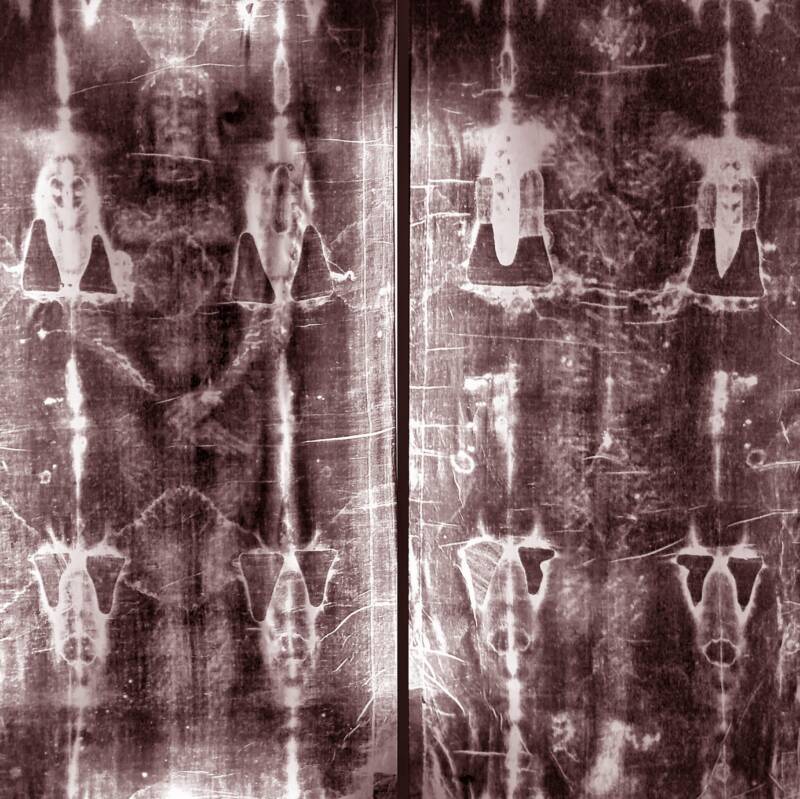Stored in Turin, Italy since 1578, the Shroud of Turin seemingly bears the image of a crucified man — who some believe was Jesus of Nazareth.

World History Archive/Alamy Stock PhotoSome believe the Shroud of Turin is the burial cloth of Jesus Christ, but its authenticity has been debated for centuries.
In the 1350s, a knight in Lirey, France came into possession of a peculiar object. There is no record where he found it, who he got it from, or where it originally came from. But it was, the knight claimed, an ancient burial shroud imprinted with the likeness of Jesus Christ. And the world has been debating the authenticity of the so-called Shroud of Turin ever since.
If it’s genuine, the Shroud of Turin is an astounding artifact. It seems to bear the imprint of a man who was crucified — and endured painful injuries from thorns on his head and wounds on his back from flogging.
So is the Shroud of Turin real? Studies performed on the object have turned up conflicting results. But the most recent investigation concluded, with some caveats, that the artifact could be about 2,000 years old.
The Murky Origins Of The Shroud Of Turin

The History Collection/Alamy Stock PhotoFrench knight Geoffroi de Charny, seen here in his tomb brass, acquired the Shroud of Turin in the 14th century.
The Shroud of Turin first appears in the historical record during the 14th century. In 1355, it was put on public display in Lirey, France, after it was brought forward by a French knight named Geoffroi de Charny (sometimes also spelled Geoffroi de Charnay or Geoffrey de Charny) — who claimed that it was the burial shroud of Jesus Christ. Though the knight left no record about where he’d found the cloth, his military career had likely taken him to many places, including Smyrna, an ancient Greek city in present-day Türkiye. That said, de Charny died in 1356 before he could be thoroughly questioned.
Though its origins were dubious, the Shroud of Turin looked tantalizingly authentic. Measuring about 14 feet, 3 inches long and 3 feet, 7 inches wide, the cloth seemed to show the faint imprint of a man who had been crucified. It looked as if the man had been laid down on the cloth, then wrapped in it, leaving an impression of his face and his injuries.

Public DomainA close look at the face imprinted on the Shroud of Turin.
It thus offered to answer questions about what Jesus Christ had looked like and even Christ’s height (the figure in the shroud stood 5 feet, 7 inches tall). What’s more, it seemed to confirm the torture that Jesus Christ had suffered during his execution at Golgotha. The man in the shroud seemed to have injuries consistent with crucifixion, including wounds near his hands and on his feet (possibly from nails), marks on his head (possibly from a crown of thorns), and injuries on his back (possibly from being flogged). The shroud was also stained with a dark material that looked like blood.
But the object drew both awe and objections from the start.
As the Shroud of Turin drew pilgrims to Lirey, it also drew the critical eye of the Catholic Church. In 1389, the bishop of nearby Troyes wrote to Pope Clement VII to inform him that it was a fraud, claiming that it was “cunningly painted” and that the artist behind the stunt had confessed “the truth.”
Clement ruled that Lirey could continue to display the Shroud of Turin, but that they would have to specify that it was an “icon” and not a historical “relic.” That said, the debate over the Shroud of Turin’s status as an “icon” versus a historical “relic” would continue for several centuries.
Fire, Water, And Doubt: The Chaotic History Of The Religious Object

Public DomainThe Shroud of Turin was in the possession of the Savoy family for centuries.
The Shroud of Turin stayed in Lirey for decades. But in 1418, as fighting during the Hundred Years’ War moved precariously close to the town, Geoffroi de Charny’s granddaughter Margaret de Charny took the object into her possession to protect it. Though officials in Lirey tried to reclaim the shroud starting in the 1440s, Margaret decided to start exhibiting it elsewhere. In 1453, she sold it to the royal house of Savoy in exchange for two castles.
For this, Margaret was excommunicated. And the Shroud of Turin remained with the Savoys until 1986, when it was bequeathed to Pope John Paul II.
Over the centuries, the shroud faced various trials and tests, and church officials went back and forth about its authenticity. In 1503, a Savoy courtier claimed that the shroud was indisputably holy since it had been burned, boiled in oil, and even laundered, but “it was not possible to efface or remove the imprint and image.” In 1506, Pope Julius II seemed to agree when he declared that the shroud was not just an icon but an authentic relic.
In 1532, a fire broke out at Sainte-Chapelle in Chambéry, France, where the shroud was being held, badly damaging the garment. The object had been stored in a container that was adorned with silver, which melted onto the shroud and burned it. Burn marks — and water marks from extinguishing the fire — can still be seen on the shroud to this day.

Florian Pépellin/Wikimedia CommonsThe façade of Sainte-Chapelle in Chambéry, left, where the Shroud of Turin was kept in the early 16th century.
The object was later moved to Turin, Italy in 1578, where it has been ever since (and where it got its name: the Shroud of Turin). Today, those who wish to view it can see it at Turin’s Chapel of the Holy Shroud.
For a long time, the Catholic Church was largely silent on the shroud. And when popes did speak of it in the 20th century, they often had conflicting opinions about how to describe it. Pope Pius XII called it a “holy thing perhaps like nothing else” in 1936; in 1980, Pope John Paul II described it as a “relic,” which was “linked to the mystery of our redemption.”
But John Paul II also remarked in 1998 that the Shroud of Turin was “not a matter of faith.” The pope admitted that the Catholic Church “does not have the proper competence to pronounce on these matters” and thus “she entrusts scholars with the task of carrying out further research in order to find answers to questions relating to the Shroud…”
Indeed, scientists have long tried to determine the truth about the Shroud of Turin. But their investigations have also turned up mixed results.
Is The Shroud Of Turin Real? Here’s What The Science Says

Krzysztof Dobrzański/Wikimedia CommonsStarting in the 20th century, scientists tried to determine the truth about the Shroud of Turin — with mixed results.
For centuries, veneration of the Shroud of Turin was based on faith. But starting in the 20th century, scholars sought to unravel the shroud’s secrets with science. However, even though they’re now armed with new technology, they haven’t yet made a definitive call on the shroud’s authenticity.
In the 1970s, one study suggested that the blood patterns on the cloth corresponded with someone who had died from crucifixion. A study in 2018, however, contradicted this by examining the position of the bloodstains. In the 1980s, another study used carbon dating to determine the age of the shroud, and found that the cloth dated back to between 1260 and 1390 C.E. — around the time when the object first appeared. This seemed to suggest the artifact was a medieval forgery. But a more recent study in 2022 found that the shroud could, in fact, date back to the first century C.E. If true, that would mean that the object came from the age of Christ.
This study argued that most of the shroud’s natural aging could have occurred before the 14th century. After that point, it was stored in cooler areas in Europe, which the scientists believe slowed its aging.
“The degree of natural aging of the cellulose that constitutes the linen of the investigated sample, obtained by X-ray analysis, showed that the [Turin Shroud] fabric is much older than the seven centuries proposed by the 1988 radiocarbon dating,” the experts argued in their study, published in Heritage.

Heritage/De Caro et al.A 2022 study argued that the Shroud of Turin could potentially be about 2,000 years old.
So is the Shroud of Turin real? Even if the 2022 study is accurate — and the study’s researchers stated that a “more systematic” analysis was needed — it only proves that the shroud came from the first century. It does not prove that it was used as a burial shroud for Jesus Christ specifically.
But the Catholic Church does seem to see it as an important object, even if more recent popes have avoided calling it a historical relic outright.
In 2013, Pope Francis called the Shroud of Turin an “icon of a man scourged and crucified.” He added that the centuries-old garment “invites us to contemplate Jesus of Nazareth… [and that] this disfigured face resembles all those faces of men and women marred by a life which does not respect their dignity, by war and violence which afflict the weakest.”
After reading about the Shroud of Turin, learn about when and where Jesus Christ was born. Then, go inside Jesus’ alleged tomb.





